Multi-Pip Saxophone Neck Experiment
By Curt Altarac
There are many factors to consider when adjusting saxophone intonation and tone. Sometimes, when I tune and tone an instrument, I come to a point when I've tried everything and the problem still persists. These situations provide a great opportunity to explore new ideas. I have had situations where I believed the octave pip was causing some problems with intonation after all other avenues were exhausted. Trying to learn about the octave pip and what it does, I began to experiment. These experiments were very successful and lead me to learn about and understand the working of an octave pip by creating the Multi-Pip experimental neck.

The Multi-Pip neck was made so I could compare octave pips that varied in diameter, height, length, location and shape. The goal of this experiment was to gain a working knowledge of the octave pip and how it affects intonation and tone. Although it was an excellent learning tool, the Multi-Pip neck did not allow for quick octave pip changes. This neck was most useful for trying different octave pip locations but not very useful for comparing various shape, length and diameter pips to each other in the same locations.
With help from Matt Scott, saxophone repair technician at MusicMedic.com, the threaded-pip neck was created along with over 20 different pips. This neck allows us to observe the effects of changing the location and shape of an octave pip.
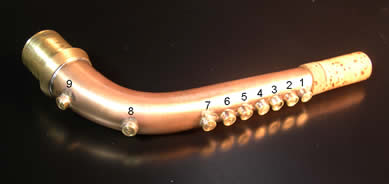
The Threaded Pip Neck varies from the Multi-Pip neck in that only one pip need be created on the lathe, and that pip can be placed in every threaded location. Rather than having to solder all pips of one type, length or shape into each location, it is now possible to move one pip to various locations. This flexibility was key to a successful experiment.
We discovered that various aspects of the octave pip greatly affect tone and intonation. Understanding the tonal and intonational effects of the octave pip will benefit some technicians and all manufactures. The difficulty is taking into account the tonal and intonational changes and applying them together to solve a problem or improve a design. The goal of this experiment was to solidify our understanding of the octave pip as it relates to intonation only. Tone was taken into account only when the notes on the instrument would not speak clearly with a given pip.
The Multi-Pip neck experiment was designed to discover what effect the following changes to the octave pip would have on intonation:
- Center hole diameter
- Longer or shorter
- Tapering
- Threading
- Location
From a manufacturing perspective, will wanted to find the 'best' location, size, height and shape with the threaded-pip neck. The series of experiments were very successful in answering these questions.
The test was done in our repair facility by three people. Each person with a unique job.
The pip setter labeled each pip and placed the pips in the Threaded Pip neck. The pip setter is the only one in the experiment who knew what pip and location was being tested. <br
The player had the job of playing the notes on the saxophone from top line F to palm-F. The player had no idea what pip or location he was playing.
The observer notated the tone response and intonation while the player played.
Each pip is a threaded tube soldered on the neck with a center hole. The original location of the this neck's pip is number 5. Along with the threaded pips that were made, threaded plugs were created to plug the holes for the pips not being used. The pips do not extend into the bore of the neck they are flush with the bore.
Results from the experiment were put into a spread sheet and analyzed. The results were congruent with the previous study done on the early Multi-pip neck yet more quantifiable. Each of the questions were answered satisfactorily and clearly. There are several more experiments that we plan to use this threaded-pip neck for and there are more conclusions to be drawn from the data.
How does moving the Pip affect intonation?
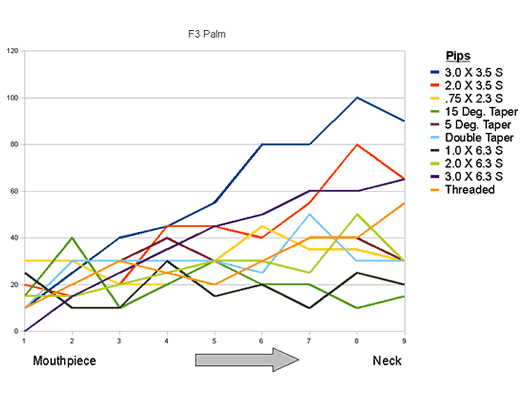
Although each pip has it's own unique intonation tendencies, there are general tendencies between the pips when compared to each other in different locations. From the chart above note the following:
The numbers 1 thru 9 on the bottom correspond to pip locations working down the neck.
Each different color line is a different pip.
This chart shows intonation for the note F when played on various pips in various locations.
The Chart above is for Palm F. From this chart it is easy to see that the pitch gets sharper as the note is played with pips lower on the neck.
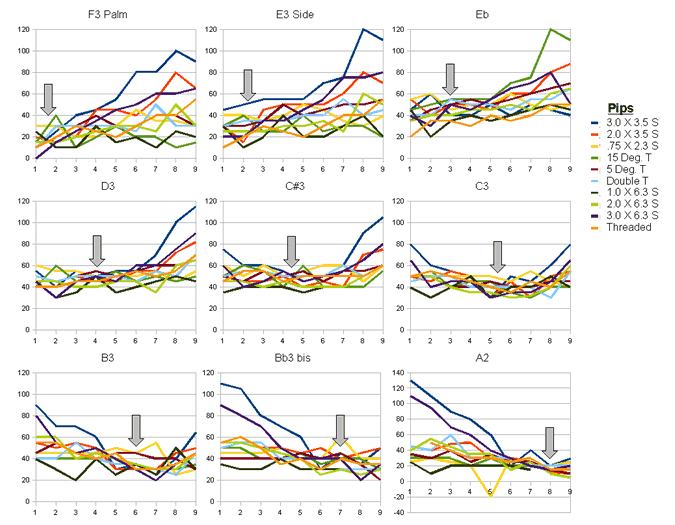
When we add the data from each note and not just palm F, you see that the best pip location for F, which is the location where most pips play with the same and best intonation, may not be the best location for other notes when this pip is used.
It appears that as lower notes are played, lower pip placement is more appropriate. Looking at the overall intonation for the various notes, that the optimal location for notes C and C# are also the optimal compromise location for the pip in general
What is the best location for the octave pip?
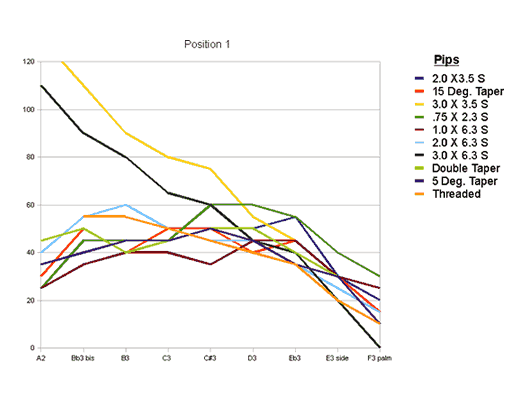
This chart shows intonation for various notes and various pips when when the pip is placed in location 1. Based on this study, using this neck and this instrument, the best location would be the place where the notes in general play in tune together and ultimately in tune with the lower octave. I believe that the best location for a pip is one where the various pips tend to play with a similar intonation. In location 1, some pips give very different intonation.

Here you can see the results of our testing for the various locations down the neck using each different pip and playing notes from A to F. When pips higher on the neck are played, the lower tones are sharper. When pips lower on the neck are played, the higher tones are more sharp. There seems to be a central location where the the higher and lower tones are close to each other from an intonation standpoint.
How does the diameter of an octave pip effect intonation?
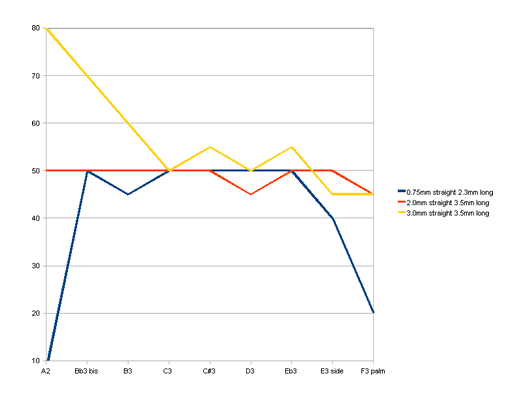
Looking at this chart, you can see three different diameter pips are compared. These comparisons were obtained by averaging each pip over 4 different locations. Based on this information, it appears that pitch goes up as the pip diameter increases.
How does pip length effect intonation?

The first chart shows three short pips and their intonation. The second chart shows three longer pips of a similar diameter. Note that the pitch of these tones in general gets flatter as the length of the pip increases.
How does tapering effect intonation?

Here you can see three tapered pips and two straight pips compared. The tapered pips have a similar intonation to the straight pips of a similar average diameter. That is, getting an average of the larger and smaller diameters of a tapered pip will give you an average diameter of a pip. The tapered pips have similar intonation to straight pips with a diameter that corresponds to their average diameter.
How does threading a pip effect intonation?
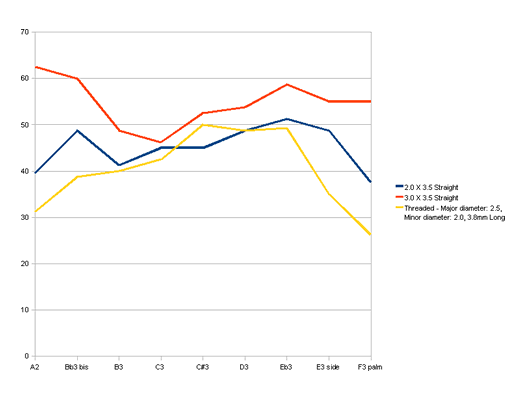
Threads have both a major and minor diameter. Threading a pip will give it intonation similar to a non threaded pip with a diameter that corresponds to the threaded pips minor diameter. Or, as threads are cut from a hole of equal to the minor diameter of the threads, threading a pip does not change the intonation; so long as the proper tap is used.
Octave pip location and size have a real effect on the intonation of a saxophone in the octave where the pip is open. The length, diameter, shape and location have an great effect on how well a pip functions. Speaking only about intonation, the following is what one can expect:
- As notes are played on pips lower down the neck, high notes get sharper and low notes get flatter.
- In general, pitch gets sharper as the pip diameter increases.
- The pitch gets flatter as the pip length increases.
- Tapered pips have somewhat similar intonation to pips with a diameter equal to the average of the min and max diameters of the taper.
- A threaded pip has similar intonation to a straight pip with a diameter equal to its minor diameter.
Copyright © 2000-2012
MusicMedic.com
All Rights Reserved